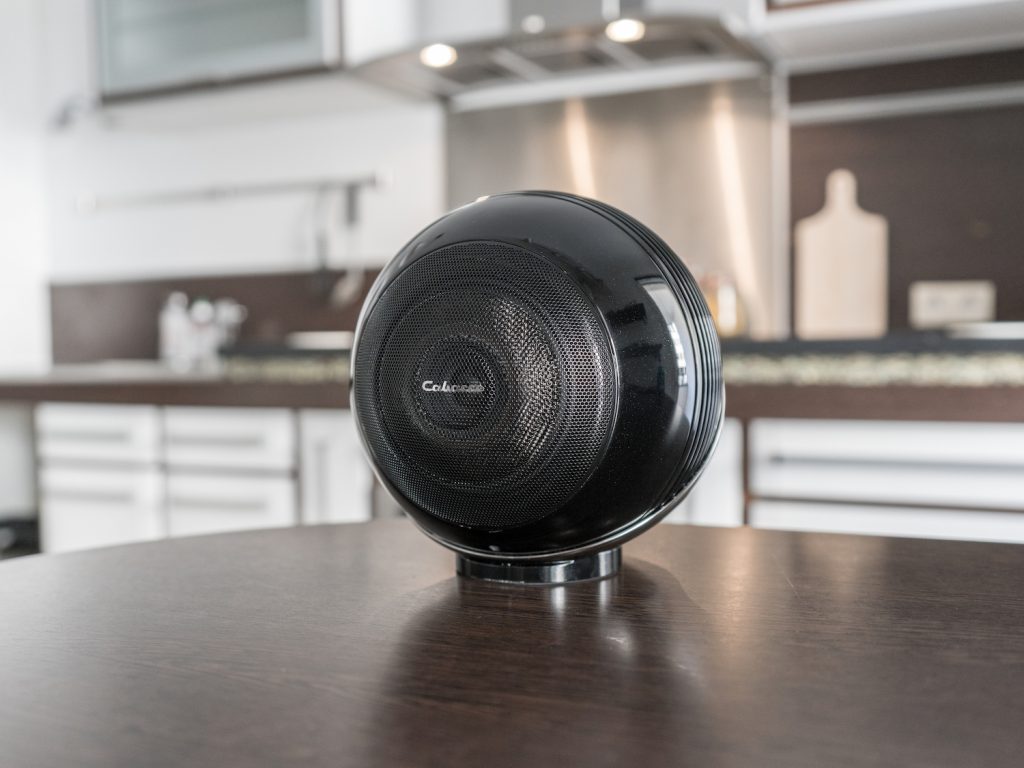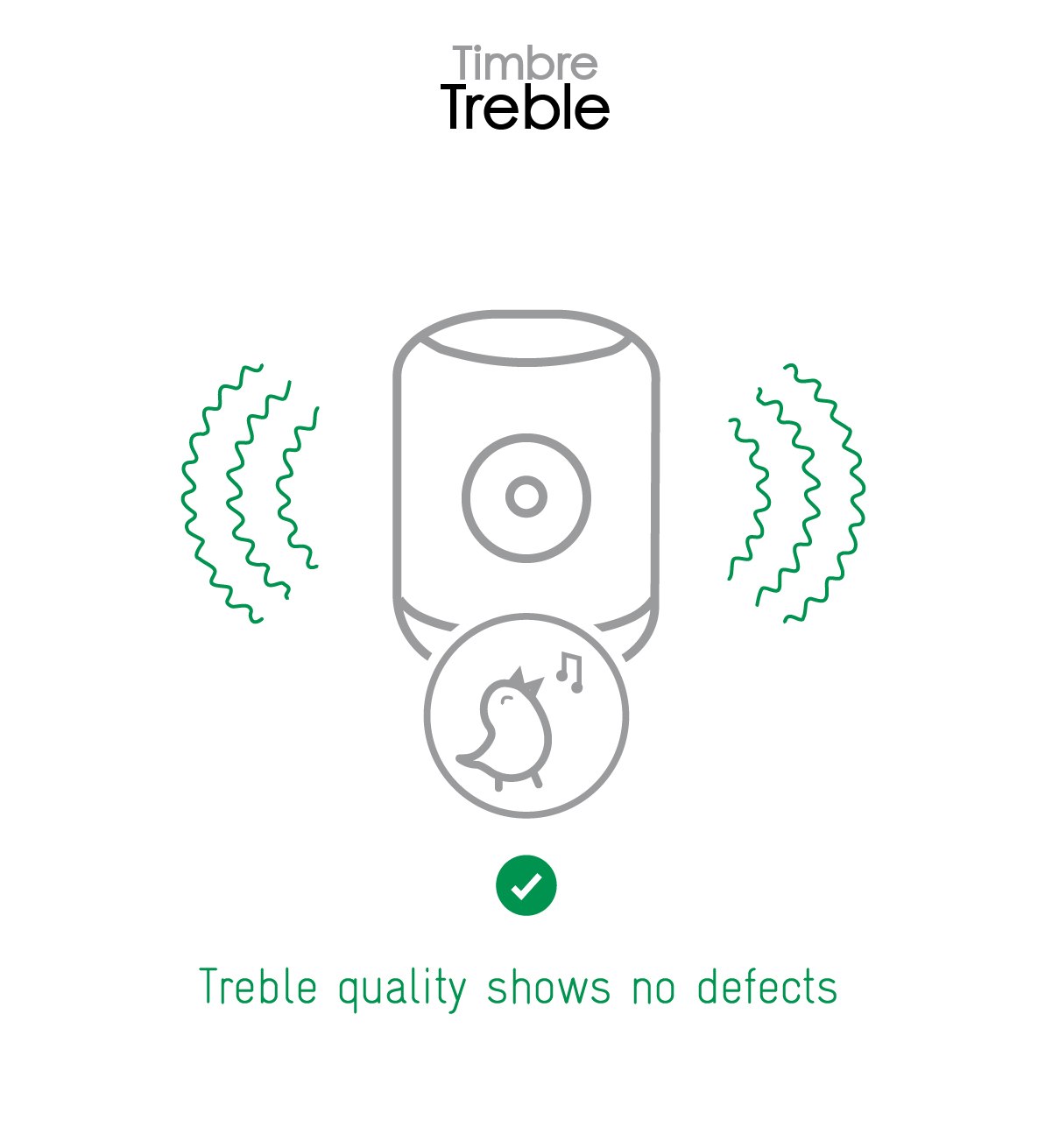The Pearl Akoya wireless speaker by Cabasse is a smaller version of the original Pearl, which was about the size of a regulation basketball. The Pearl Akoya is about the size of a volleyball (22 cm in diameter), but there is a lot packed into that modest orb, which weighs a hefty 6 kilos. Elegantly designed and sleek, it nonetheless can blast out 115 decibels, according to Cabasse, which says the speaker “offers exceptional acoustic quality and power that is comparable to that of a classical orchestra, all from a small package.”
We put the Pearl Akoya through our rigorous DXOMARK Wireless Speaker test suite. In this review, we will break down how it fared at audio playback in a variety of tests and several common use cases.
Key specifications include:
- Medium-tweeter, 13 cm coaxial BCI; woofer, 17 cm HELD; tweeter, 300 W RMS / 600 W peak; medium, 300 W RMS / 600 W; bass, 450 W RMS/ 900 W peak
- Connectivity: Ethernet/WiFi – Bluetooth – SPDIF Optical – RCA Analog – USB for music on external hard drives — jack
- 22 cm x 22 cm x 22 cm (8.6-inch diameter)
- 6 kg (13.2 pounds)
Test conditions:
- Tested with Apple iPhone for music /Xiaomi Mi TV Box S for movies
- Communication protocol used: Cabasse App version 4.0.2 via wifi/3.5 mm jack input for movies
- Firmware version: 20.03.17
About DXOMARK Wireless Speaker tests: For scoring and analysis in our wireless speaker reviews, DXOMARK engineers perform a variety of objective tests and undertake more than 20 hours of perceptual evaluation under controlled lab conditions. This article highlights the most important results of our testing. Note that we evaluate playback using only the device’s built-in hardware. (For more details about our Speaker protocol, click here.) Cabasse the Pearl Akoya falls into the Premium category of devices in the DXOMARK Speaker rankings.
Test summary
 Cabasse The Pearl Akoya
Cabasse The Pearl Akoya


Pros
- Excellent treble and midrange at almost all volumes
- Great attack at all volumes
- Good localizability and distance performances
- Virtually no artifacts
Cons
- High level of volume dependency means tonal balance shifts at different volume levels.
- Bass is limited at higher volumes.
- No wideness, as it’s not a stereo device.
The Pearl Akoya, with its global score of 144, is among the highest-performing devices in the Premium category of our wireless speaker database, eight points down from the current top score holder, the Bowers & Wilkins Formation Edge, but just three points down from the previous, longstanding No. 1, the Harman Kardon Citation 200. Our engineers were impressed by the Pearl Akoya’s midrange and treble performance, calling it excellent. At almost all volumes, these frequency ranges were even and pleasant. The attack was great at all volumes — clear and concise. Bass precision was good at low and nominal volumes, and the localizability and distance performances were also singled out for praise.

While the device can be paired with another Pearl Akoya or other compatible speaker to create stereo sound, it was tested as a single device, thus it was mono, with no wideness.
As for drawbacks, the low-end compression and low-end limiting seriously affected the bass performance of the Pearl Akoya. The louder the volume, the more limited the bass became in our testing. At full volume, bass was almost inaudible. From 100 Hz to 300 Hz, there was a notable lack of bass and midrange. The volume steps weren’t very consistent: the highest three volume steps were the same.
Sub-scores explained
The DXOMARK Speaker overall score of 144 for Cabasse The Pearl Akoya is derived from a range of sub-scores. In this section, we will take a closer look at these audio quality sub-scores and explain what they mean for the user, and we will share some comparison data from some of the Pearl Akoya’s principal competitors.

Timbre
Cabasse The Pearl Akoya
139
152
DXOMARK timbre tests measure how well a speaker reproduces sound across the audible tonal range and takes into account bass, midrange, treble, tonal balance, and volume dependency.
The Pearl Akoya earned a very good score in timbre, with overall good tonal balance. But the timbre of the device was extremely volume-dependent, meaning that the tonal balance shifts markedly as volume levels change. At low volume, the Pearl Akoya suffered from a lack of treble, causing sound to be muffled. But on the other hand, bass was good at this level because it was no longer inhibited by low-end compression. At nominal volumes, there was a lack of low-end extension, a lack of low mids from 100 Hz to 300 Hz, and slightly less treble than other top performers at nominal volumes.

At loud volumes, the lack of bass and low-end extension becomes very evident. And at maximum volume, the bass and low-end becomes almost inaudible compared with the high mids and treble. The top-end portion of the sound spectrum, however, is very clean and pleasant to listen to.
In noisy environments, the device’s performance suffered because of its lack of low midrange and the slight lack of treble.



Dynamics
Cabasse The Pearl Akoya
131
137
Our dynamics tests measure how well a device reproduces the energy level of a sound source, taking into account attack, bass precision, and punch.
The Pearl Akoya earned an excellent score for dynamics. It demonstrated good attack characteristics at all volumes, but did suffer when extremely dynamic content was played. In that case, attack blurs into the background, and everything occurs at the same volume. Bass precision is good at low and nominal volumes, but the performance is hindered by limiting issues at high levels. Punch is also affected by this same limiting issue in the party use case, even if the overall performance is good. At maximum volume, compression makes bass almost unintelligible.



Spatial
Cabasse The Pearl Akoya
85
111
Our spatial tests measure a speaker’s ability to reproduce stereo sound in all directions, taking into account localizability, balance, wideness, distance, and directivity. Please note that wideness is 0 on mono speakers and on speakers that cannot deliver a significant stereo effect.
The Pearl Akoya turned in an average performance in the spatial attribute. The speaker has precise localizability and good distance rendering, but suffers in loud environments because of a lack of high end and low mids, which makes voices disappear into background noise.
The Pearl Akoya is mono, so it received a 0 for wideness. Because of the design of the device, with a front-firing treble speaker and a rear-firing bass speaker, directivity performance is very limited. The speaker didn’t do well in 360-degree testing because of inconsistent tonal balance.


Volume
Cabasse The Pearl Akoya
99
141
Our volume tests measure both the maximum loudness a speaker is able to produce and how smoothly volume increases and decreases based on user input.
The Pearl Akoya earned an average score for volume performance. The volume consistency, in fact, was below average. The last three volume steps are virtually the same, as you can see in the chart above. Considering the size of the Pearl Akoya, the maximum volume was good.

Here are a few sound pressure levels (SPL) we measured when playing our sample recordings of hip-hop and classical music at maximum volume:
| Correlated Pink Noise | Uncorrelated Pink Noise | Hip-Hop | Classical | Latin | Asian Pop | |
| Cabasse The Pearl Akoya | 86.9 dBA | 84.2 dBA | 85 dBA | 76.2 dBA | 86.9 dBA | 77.9 dBA |
| Devialet Phantom II 98 dB Opéra De Paris | 87.9 dBA | 87.4 dBA | 84.3 dBA | 77.8 dBA | 86.4 dBA | 77.7 dBA |
| Naim Mu-so 2nd Generation | 90 dBA | 86.8 dBA | 87 dBA | 81.3 dBA | 87.3 dBA | 82.8 dBA |

Artifacts
Cabasse The Pearl Akoya
129
133
Our artifacts tests measure how much source audio is distorted when played back, along with such other sound artifacts as noise, pumping effects, and clipping. Distortion and other artifacts can occur both because of sound processing and because of the quality of the speakers.
Cabasse the Pearl Akoya earned an excellent score for the artifacts attribute. No disturbing artifacts were perceived, but a serious amount of compression is present on the low end with the speaker at high volume or when reproducing dynamic content.

Conclusion
Low-end limiting had a big impact on the bass performance of the Pearl Akoya — the louder the volume, the more limited the bass, and at full volume, bass was almost inaudible. Volume consistency was another issue; the last three volume steps are the same. Nevertheless, with excellent midrange and treble performances at almost all volumes, great attack at all volumes, and good localizability and distance, Cabasse The Pearl Akoya is deservedly among the elite performers in our database of premium home wireless speakers.

 English
English 中文
中文

DXOMARK invites our readership (you) to post comments on the articles on this website. Read more about our Comment Policy.